Explainer
- Explainer
- Evolution
No more ‘Homo stupidus’: Why Neanderthals are getting a makeover
They were shrewd, complex and creative, and we shared the planet with them (and other types of humans) for thousands of years. So why did the Neanderthals die out – and not us?
The eating is good in this picturesque pocket of north-eastern Spain. The charming ancient city of Lleida, in the foothills of the Pyrenees, boasts a Michelin-starred restaurant and any number of holes in the wall specialising in traditional Catalan delicacies: peppery pork sausages called butifarra, snails cooked in their own juices, toasted bread rubbed with ripe tomato, garlic, salt and olive oil.
When Neanderthals were living here 80,000 years ago, it wasn’t too bad, either. They rustled up hearty meals of sustainably sourced, organic fare roasted over an open fire, letting the produce “speak for itself”, as an earnest young chef might say today. On the Neanderthal menu were turtle, rabbit, bison, wild horse when seasonally available, and possibly even a hunk of woolly rhinoceros.
Yet this was no Garden of Eden. The unsettled global climate meant this region could swing between balmy and frozen, and edible prey would come and go. That small numbers of Neanderthals managed to exist here at all meant they had to continually adapt their survival strategy.
They were shrewd, resourceful and probably quite communicative – far more so than we Homo sapiens have traditionally assumed. They had to be. They successfully roamed an often hostile planet for at least 300,000 years: no mean feat.
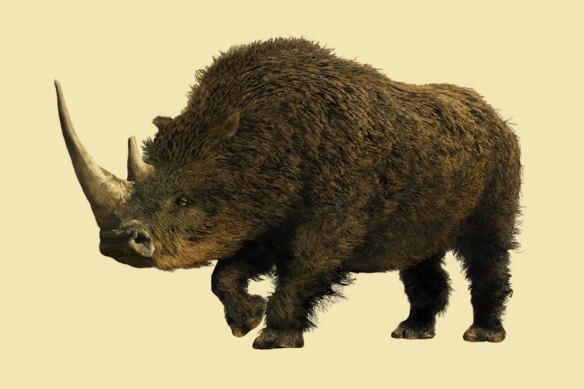
An artist’s impression of a woolly rhinoceros. Credit: Getty Images, digitally tinted
In recent years, sophisticated ways of dating ancient fossils, diligent archaeologists and a stream of discoveries have upended what we thought we knew about Neanderthal humans – and turbocharged our interest in them. Books, documentaries, podcasts; a 2022 Nobel Prize for research into their DNA. Once considered beetle-browed, hunched and brutish, the butt of a cosmic joke, Neanderthals are undergoing a public relations makeover.
But there is much we still don’t know about them. Did they make mysterious sculptures and carve the bones of ravens? And why, sometime around 40,000 years ago, did they vanish, leaving Northern Europe, the Middle East, Siberia and those Catalonian hills for Homo sapiens to eventually overrun with tapas bars and boutique hotels?
Why did the Neanderthals get a bad name?
It’s 1856 in Germany’s Neander valley, a ribbon of river in the countryside not far from Dusseldorf. Mining workers are blasting cliffs with dynamite to dislodge marble and limestone. But there are caves that must be inspected and cleared of unwanted debris first. It’s in one of these caves, known as the Kleine Feldhofer Grotte, that the workers discover fossilised bones.
Thinking they are from animals, they throw many of the bones out into the valley, but their employer, a member of a local natural history association, rescues a handful, including the top of a skull. These oddments make their way to the association’s founder, who believes the bones are human and ancient and curses the workers for discarding so many of the others.
A cast of the skull cap is sent to an anatomist, Hermann Schaaffhausen, in Bonn, who deduces that, despite its flattened shape and prominent brow, this must be from a primitive kind of human. Eventually, the findings make their way north to a British professor, William King, who has the German research translated in 1863 and presents it to a meeting of British scientists, claiming the bones are evidence of a new species entirely, which he names Homo neanderthalensis, after the valley in which it was found. (Entirely coincidentally, “Neander” means “new man”.)
‘I feel myself constrained to believe that the thoughts and desires which once dwelt within it never soared beyond those of the brute.’
This was an era in which there was a great public interest in science, exploration and discoveries. Burke and Wills had left Melbourne’s Royal Park for their outback odyssey in 1860. Charles Darwin published his The Origin of Species in 1859. Stanley found Livingstone near Lake Tanganyika (in present-day Tanzania) in 1871, later claiming to have uttered the droll greeting, “Dr Livingstone, I presume?”
One of the most prestigious areas of research at that time was anatomy, says Rohan Long, curator of the Harry Brookes Allen Museum of Anatomy and Pathology at the University of Melbourne, which has a large collection of casts made from Neanderthal and other early human fossil finds. “It was kind of cutting-edge stuff. It was like this brand-new area of science.” Into this milieu fell the Neanderthal remains, about which there was understandably much discussion. Were they human or animal? What did they tell us about evolution? Were they really worthy of a species designation (a debate that continues today)?
Not everything King concluded was particularly charitable. He wrote in 1864 that the skeletal remains more resembled those of a “carnivorous animal than those of man”. Of the skull, he wrote, “I feel myself constrained to believe that the thoughts and desires which once dwelt within it never soared beyond those of the brute.” He also volunteered, in typically censorious Victorian fashion, that the Neanderthal would have been “incapable of moral and theoistic conception”.
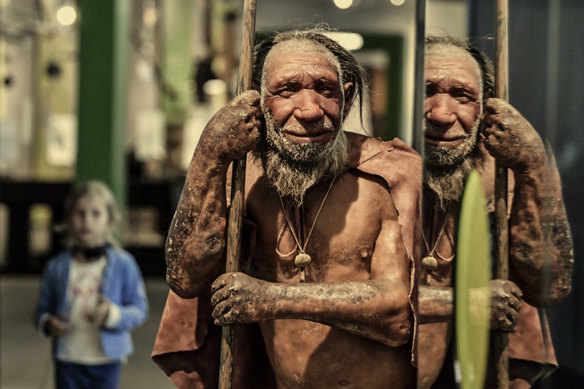
A reconstruction of a Homo neanderthalensis at the Neanderthal Museum in Mettmann in Germany.Credit: AP/Martin Meissner
Plenty of people, meanwhile, were sure the whole thing was a fraud, including the press of the day, which loved exposing hoax discoveries. A popular theory was that the bones were all that remained of a “lost, bowlegged Cossack with rickets”, recounted The New York Times in 2017. (“Piltdown Man”, the most sensational forgery of all, was to come about 50 years later, when amateur archaeologist Charles Dawson claimed to have discovered a link between apes and early man, near Piltdown in East Sussex.)
It was odd, meanwhile, that Darwin, of all people, chose to largely ignore one of the most important discoveries in his field in his lifetime, observing merely that the skull appeared “well-developed and capacious”. His ally, the anthropologist Thomas Huxley, concluded that Neanderthals must have had brains “as large as a modern human and twice the size of an ape’s”. Yet neither evidently wanted to go much further down this path.
Perhaps Darwin was keen to avoid further conflict with the religious establishment, which had ridiculed his theory of evolution, as Ian Tattersall of the American Museum of Natural History in New York has suggested. After all, it was still commonly believed that humankind had popped into being, fully formed, around the time of Adam and Eve. “It is hard not to conclude,” writes Tattersall, “Darwin was grasping at the politically congenial notion that the Neanderthaler, ancient as it was, was simply a bizarre kind of modern human.”
The unfair stereotyping of our much-maligned ancient “cousins” continued, informed by Victorian enthusiasm for phrenology, eugenics and a hierarchy of race. The Neanderthals’ more “robust” face was interpreted as being mentally deficient compared to Homo sapiens’, the University of Cambridge’s Emma Pomeroy tells us: “Less evolved, less refined, if you like. And this all ties in to ideas of racism that were quite prevalent at the time.”
Says Long: “They took it as a given that white Europeans were right at the top of the chain of existence, and non-white people were lower down. Now that we have these other primitive humans, how do they fit into these pre-existing prejudices about the progress of humankind?”
In 1911, a French anatomist incorrectly reconstructed an almost complete male Neanderthal skeleton from a cave in the La Chapelle-aux-Saints region in central France, displaying it as stooped and ape-like. This was to become the dominant representation for the best part of the century, the “knuckle dragger”, says Pomeroy, who featured in a recent BBC documentary on Netflix called Secrets of the Neanderthals. The German zoologist Ernst Haeckel proposed renaming Neanderthals “Homo stupidus”. A diorama installed in Chicago’s Field Museum in 1929 portrayed the Neanderthal as a “neckless, bone-sucking oaf”, writes Maya Jasanoff in The New Yorker.
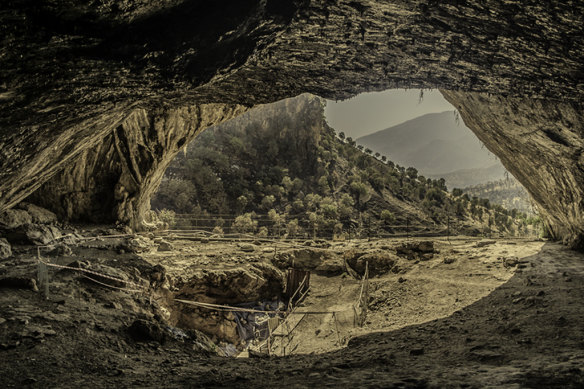
The Shanidar Cave in northern Iraq, where fossilised Neanderthal remains were found. Credit: WikiCommons. digitally tinted
What were the Neanderthals really like?
They were stockier than Homo sapiens and had different ranges of physical movement, for better or worse. They didn’t have a chin – perhaps explaining why “chinless wonder” lingers as an insult. But that characteristic skull, with its heavy brow, carried a brain that was as large as that of Homo sapiens’. Its shape – more elliptical and elongated than ours – may have favoured the development of slightly different cognitive functions. It’s been suggested that Homo sapiens had a larger cerebellum, the part of the brain responsible for motor skills, language, learning and reasoning, and social abilities, which may have helped us to be more successful, ultimately (although theories abound, more on that later).
We were at least beginning to think of them as more than mere “cavemen” by 1939 when the US anthropologist Carleton Coon produced an image of a Neanderthal wearing a hat and tie to argue that our differences were actually quite minimal.
Flash forward to contemporary Belgium, and we meet the Kennis twin brothers, Adrie and Alfons, who have made an unusual living from reconstructing models of long-departed humans in surprisingly lifelike postures. Many of their commissions have been of Neanderthals, such as their reconstruction of a woman known as Shanidar Z, recreated for the recent Netflix documentary from skull fragments painstakingly pieced together by Emma Pomeroy’s team at the University of Cambridge.
The finished work is part science, part art, Alfons Kennis tells us from his studio in Arnhem, near the German border. “It’s not a forensic reconstruction because people in the area have to interpret it for themselves,” he says. They know what the bones were like and how skin would have stretched across them, but more subtle facial features had to be reimagined, he says. The intention, though, is to show how she might really have appeared.

The Kennis brothers examine a 3D printout of the skull of Shanidar Z. This is what they used as a basis for the recreated head. Credit: Secrets of the Neanderthals/Netflix, tinted
Did Neanderthals “speak”? Studies using software to simulate how their vocal tract worked suggest they made different vowel sounds and probably were able to cry out more loudly than Homo sapiens due to a larger voice box and lungs.
Their physiology clearly served them well in their European habitat, which was at times extremely cold – think, mile-thick ice for thousands of years – but had abundant food if you could catch it, including reindeer and horses. Yet they didn’t depend entirely on big game, as was once thought. They ate shellfish, as did Homo sapiens. Recent fossil studies have indicated Neanderthals who lived in what are now Belgium and Iraq ate date palms, legumes such as lentils, and grass seeds, some of which had been cooked. The remains of two adults in Belgium had traces of grasses and water-lily-root starches; a sample from El Sidron, in Spain, showed pine, mushrooms and moss. Critically, says ANU PhD student and archeologist Eboni Westbury: “To consume starchy foods and tubers, you clearly need a complex understanding of fire (how to start a fire, fuel it, control it and extinguish it), which is another behaviour that has previously been relegated to anatomically modern humans.”
‘Some people will come up with interpretations of ritual or religion or symbolism. Why not? But how to prove it?’
Westbury, who has studied thousands of bone fragments from the Spanish fossil sites since 2022, says new finds have shown that our distant cousins were also able to catch faster-moving animals, such as rabbits and birds, using complex hunting strategies. “Neanderthals were actually just as capable of hunting and gathering and fishing and doing all these things that previously we didn’t think that they were able to do,” she says.Not to mention surviving meeting other competitors, such as cave bears (Westbury has a tooth from one). “I want to continue on this path of looking at their complex behaviours,” she says. “Elevating them from their previous status and helping to deconstruct this human superiority complex that we have.”
Recent archaeological finds, meanwhile, suggest Neanderthals had a creative bent. They buried their dead with what were presumably important or symbolic objects such as animal skulls and what appear to be flowers. They made tools to break bones, used stone-tipped spears to hunt prey and employed clever strategies to find and trap their food, including luring animals over cliffs into ravines. They collected feathers and used pigments, presumably for decoration.
Deep in a cave in south-western France, they built sculptural semicircular walls from stalagmites. “The big question is why they made it,” asked Jean-Jacques Hublin, a palaeoanthropologist at the Max Planck Institute for Evolutionary Anthropology, in the journal Nature in 2016. “Some people will come up with interpretations of ritual or religion or symbolism. Why not? But how to prove it?”
One particularly creative Neanderthal carved regularly spaced notches in a raven bone. Again, we don’t know why. “It has been proposed that talons and big feathers were used as personal ornaments, but in reality, we don’t have any direct evidence that this was the case,” Francesco d’Errico of the University of Bordeaux, France, told New Scientist in 2017.
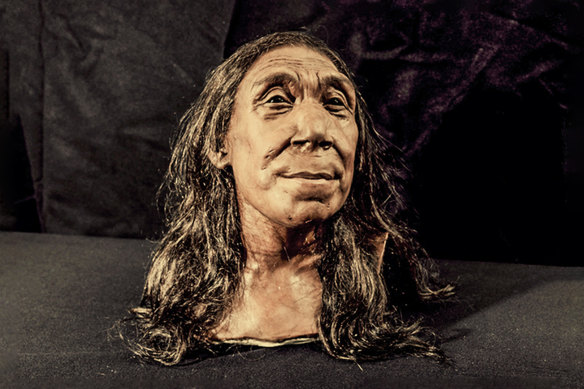
The recreated head of Shanidar Z, based on 3D scans of the reconstructed skull, made by the Kennis brothers for the Netflix documentary Secrets of the Neanderthals.Credit: BBC Studios/Jamie Simonds, digitally tinted
Were the Neanderthals our ancestors or our cousins?
We’re now in 1970 with young anthropologist Chris Stringer, who has just started working on his PhD in Bristol. The dominant view is that they were a subspecies of H. sapiens. Stringer decides to test this theory.
He works on the basis that evolution generally happens incrementally: that it can take hundreds of thousands, if not millions, of years for new species to emerge. For a Neanderthal to eventually morph into Homo sapiens there must have been transitional steps. “The brow would get smaller, the jaw would gradually develop the chin, the skeleton will gradually get more lightly built, and so on,” Stringer tells us from London’s Natural History Museum, where he’s now a professor and research lead.
‘I was pretty confident that the Neanderthals, in Europe at least, were not our ancestors. They were too different.’
Stringer travels to museums all over Europe, examining their fossil collections. There is no evidence of any “in-between” skeletons. By 1974, he came to what was, at the time, a radical conclusion. “I was pretty confident that the Neanderthals, in Europe at least, were not our ancestors. They were too different. And there was so little time gap between the Neanderthals and the early Homo sapiens that it was impossible that one could have evolved into the other.”
Over the next two decades, as the technology used to date fossils improved, Stringer’s conviction grew ever stronger. One clincher was the discovery of Homo sapiens fossils that were clearly older than those of some Neanderthals. We must have co-existed.
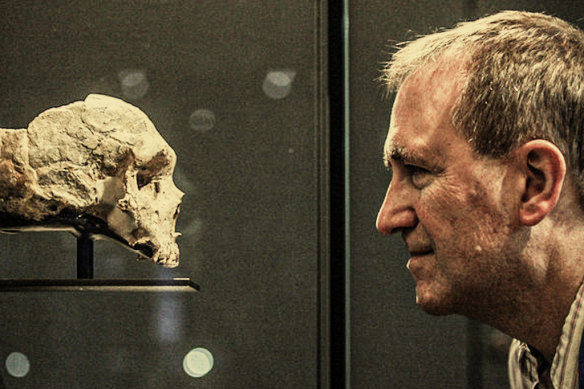
Chris Stringer with a Neanderthal skull at the Natural History Museum in London in 2012. Credit: Getty Images, digitally tinted
In 1994, Stringer published a landmark study with archeologist Clive Gamble that pretty much laid the “evolution” argument to rest. In 2004, he was made a fellow of the Royal Society, in the company of Stephen Hawking, David Attenborough, Isaac Newton and Charles Babbage, for his work on African fossils and for demonstrating that “Neanderthals represent unlikely ancestors for modern humans”.
We now know Neanderthals were not a monkey-like primate a step behind us on the family tree, but a genetically similar contemporary with whom we once crossed paths and even mated, “an interesting parallel lineage of humans,” says Stringer.
‘We’ve got quite used to being the only humans. But there would have been a lot more.’
Originating in prehistoric Africa, we shared a common ancestor – possibly Homo heidelbergensis but more likely a more ancient species – before we went our separate ways over 500,00 years ago. The group who would become the Neanderthals evolved in Eurasia, colonising Europe and parts of Asia, while Homo sapiens evolved in Africa (we were to meet again much later on). We didn’t grow apart all that far: evolution, again, is very slow. A recent study led by the University of Oxford’s School of Archaeology shows that genetically, ancient humans and Neanderthals were more similar than polar bears and brown are today.
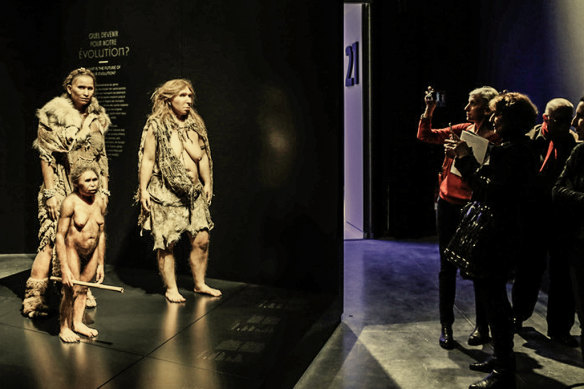
A museum exhibit with (from left) a Homo floresiensis, a Homo sapiens and a Neanderthal woman in a science and anthropology museum in Lyon, central France, in 2014.Credit: AP, digitally tinted
And like bears, there were once several kinds of humans at various times. Says Eboni Westbury: “Depending on the region of the world, there were anywhere between two and seven ‘Homo’ species coexisting.” Such as “Lucy”, the three-something-million-year-old Australopithecus afarensis skeleton discovered in East Africa in 1974. More recent finds include the three-foot-tall Homo floresiensis – the so-called Hobbit – on the Indonesian island of Flores in 2003; the mysterious Denisovans, identified from remains in Siberia in 2010; Homo naledi (from South Africa); and Homo luzonensis (from the Philippines).
“We’ve got quite used to being the only humans,” says Macquarie University’s Kira Westaway, who specialises in early human evidence in South-East Asia. “But there would have been a lot more. Obviously, a lot of them were completely unsuccessful. The game changer will be if we get some ancient DNA from some of these species in Asia; I think that would be critical to see who they were derived from and who they’re related to.”
Humans in history, and (roughly) when they died out
Why did they become extinct – and why didn’t we?
“It’s not the answer you want to hear,” says Stringer, “but we still don’t know why we’re here, and the Neanderthals aren’t.” It’s commonly thought that Homo sapiens was the culprit, but it’s likely a combination of factors was to blame.
Small population size, for one, made the Neanderthals vulnerable. Some estimates put peak Neanderthal at a population of around 50,000, dispersed in family groups and small clans across Europe. For much of their existence, there would have been far fewer.
‘You come back to this question of, well, if they survived many of these before, why now?’
“Maybe at their peak, there could have been hundreds of thousands of Neanderthals in Europe and Asia, but it was never millions, or hundreds of millions, in the way we are today,” says Stringer. This led to inbreeding. Says Pomeroy: “We know from various species going extinct today that once they get to a certain level of inbreeding, they’re extremely vulnerable. You’re so vulnerable to developmental problems, to disease – because you haven’t got that variation in the immune genes. It’s quite a plausible factor.”
Another popular theory, she says, is that climate change played a role. Except, she says, “The problem with that idea is that there were big fluctuations in climate during that time, and they’d survived these kind of fluctuations before. So again, you come back to this question of, well, if they survived many of these before, why now?”
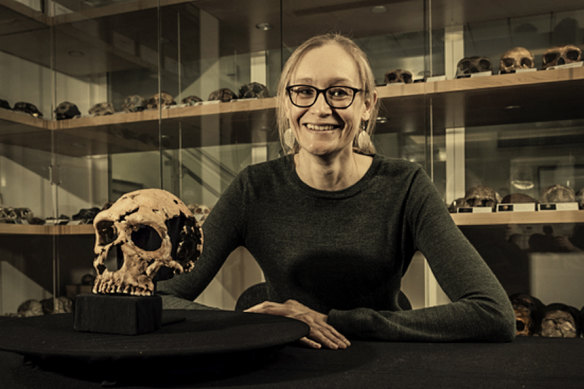
Dr Emma Pomeroy of the University of Cambridge with the skull of Shanidar Z.Credit: BBC Studios/Jamie Simonds, digitally tinted
Ok, let’s try another idea. Stringer also suggests that, compared to Homo sapiens, due to their physiology, the Neanderthals needed more energy to survive, with possibly 20 per cent more lung capacity than us day to day, so they were more demanding on their immediate environment. When times were good, they thrived, relying on strength and muscle power. When the pickings were slim, they struggled more than we did.
Then there’s us, and the effect we might have had on the Neanderthals once we departed Africa around 60,000 years ago and headed north. “I don’t think it’s a coincidence that Homo sapiens moved into the Neanderthal areas not long before they died out,” says Stringer. “I think there was certainly an economic competition between us and the Neanderthals. Obviously, these populations are both hunter-gatherers, living off the land, they’re going to want to eat the same things.”
Indeed, says Westaway, “Homo sapiens came in, and they were very good at adapting to different niches, very good at rainforest environments, and then coastal environments, and then even desert environments, and that’s why we think that they were so much more successful.”
‘Although they’d been there hundreds of thousands of years, doing quite well, in the end it wasn’t quite enough.’
Possibly, our encounters were harmful in ways we couldn’t understand at the time. “We see parallels to that in more recent history,” says Pomeroy, “where, for example, when Europeans went over to the Americas and caused absolute devastation to the populations, bringing new diseases that those populations hadn’t encountered, so they didn’t have the immune responses to be able to fight them off.” We know from our DNA that we mated with them, but that may have favoured us, carrying more of our genes forward than theirs.
Or, more chillingly, perhaps Homo sapiens just managed to cling to life themselves while Neanderthals succumbed only due to tiny differences in strategy. “When the numbers start to dwindle, all it takes is a few inopportune moments where you don’t quite get the food reserves you need, and suddenly, you know, you’re not doing so well,” says Westaway. “I mean, it doesn’t take much to actually wipe out a population, which is really quite scary.”
By 40,000 years ago, we lose “that kind of classic Neanderthal morphology”, says Pomeroy. “Individuals who look like that just disappear, and we don’t see them. It’s like the modern human appearance predominates.“
Bottom line for the Neanderthals, says Stringer: “Although they’d been there hundreds of thousands of years, doing quite well, in the end it wasn’t quite enough.”

Swedish geneticist Svante Pääbo was awarded the Nobel Prize for his work that produced an entire sequencing of the Neanderthal genome.Credit: Getty Images, digitally tinted
Could we clone a Neanderthal from DNA?
In 2022, Swedish geneticist Svante Pääbo was awarded the Nobel Prize in Physiology or Medicine for his work that produced an entire sequencing of the Neanderthal genome. This allowed us to compare Neanderthal DNA with that of Homo sapiens, which revealed that many people of European origin have some Neanderthal DNA – around 2 per cent.
Those of us of African origin, whose long-distant ancestors never left the continent and didn’t encounter Neanderthals or their hybrid offspring, are less likely to have their DNA. Further east, people from Eastern Asia, New Guinea, Melanesia, and pre-colonial Australia have traces of not only Neanderthal but Denisovan DNA.
These fragments that remain might have an ongoing influence on us. One theory suggests more Neanderthal DNA might make you a better morning person since they were better adapted for seasonal variation in daylight compared with early Homo sapiens. We do know, from a 2020 paper co-authored by Pääbo, that people who carry a Neanderthal-inherited gene cluster might be more at risk of a severe reaction to COVID-19. Associations have also been made between Neanderthal DNA and disorders such as depression and addiction. Conversely, another Pääbo study found that carrying a Neanderthal gene variant made women less likely to experience miscarriage or bleed while pregnant.

Dr Emma Pomeroy at Shanidar Cave during recent excavations. Credit: Secrets of the Neanderthals/Netflix, digitally tinted
Could we ever reconstruct a living Neanderthal? Sequencing the genome is one thing; you’d then have to collect the actual DNA, somehow, from the DNA in living humans or from a yet-to-be-discovered long-frozen prehistoric corpse and use it to make a clone in the laboratory. Clear that, and the actual process, while possible, is still fraught with difficulty. Scientists did manage to recreate the last Pyrenean Ibex in the early aughts from a tissue sample taken from an ear, but none of the offspring survived.
In 2015, the US geneticist George Church and his research team at Harvard University successfully copied some woolly mammoth genes into the genome of an Asian elephant, bringing the prehistoric Neanderthal delicacy one step back from the dead. But he sees many issues with doing the same for an extinct human, “including, but not limited to, no compelling positive arguments and ethical counterarguments about consent, dignity, and unknown unknowns”. “Neanderthals and Denisovans were humans, and large chunks of their genomes are mixed in with modern human genomes.”
In contrast, he says, “The arguments in favour of cloning and genome engineering of pigs for organ transplants and elephants for ecosystem restoration are clear and compelling, and those projects are moving forward.”
If we did somehow overcome these hurdles and recreated a Neanderthal in a test tube, how would she cope in the modern world?
“There would be some physical characteristics that, if you looked closely, would be different from the majority of modern humans,” says Pomeroy, “but we do see a lot of variation in humans today. Behaviourally, this has been another big debate. Were they as intelligent as us, could they think in a symbolic way, in a complex way, like we do? And I think, probably the answer is they weren’t much different. We are finding more and more in the archaeological record that suggests differences, if any, were slight.”
Get fascinating insights and explanations on the world’s most perplexing topics. Sign up for our weekly Explainer newsletter.
Let us explain
If you'd like some expert background on an issue or a news event, drop us a line at explainers@smh.com.au or explainers@theage.com.au. Read more explainers here.